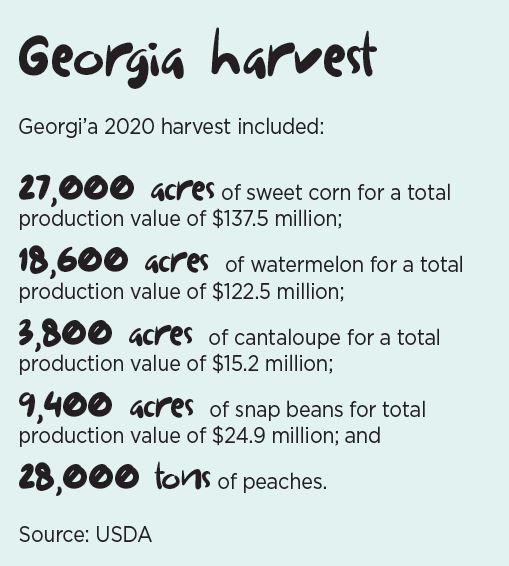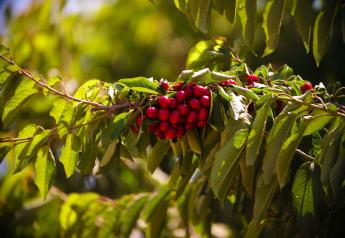A little chill didn’t hurt Georgia much

A chilly, wet winter isn’t the worst thing in the world if you’re a Georgia farmer.
A cooler December, January and February slowed the growth of broccoli, cauliflower, onions, greens and cabbage, and also brought a fair amount of rain, said Timothy Coolong, a University of Georgia horticulture professor and Extension vegetable specialist.
“The excessive rain early on caused wet fields and delayed some planting, but then the cooler spring weather has been a real advantage — just beautiful spring weather for the past eight weeks,” said Heath Wetherington, operations director at Baker Farms, Norman Park, Ga.
The leafy items benefitted from the cool weather and came in right on time, he said. The dry vegetables may be a little later than usual.
Baker Farms grows, ships and wholesales vegetables, including organic Tuscan kale and collards, and Rootables, a line of trimmed, packed beets and turnips.

The company upped its collard acreage and added more broccoli, and the rest of the crop plantings rose based on continued projected growth, Wetherington said.
The next month and a half of vegetable production looks promising, he said.
Georgia ships its crops 12 months a year, but the greatest volume is in late spring when cantaloupe, watermelon, cucumbers and squash are harvested, as well as peppers and other warm-season crops.
Plantings seem to be a similar mix to last year, Coolong said.
“South Georgia is extremely diversified in terms of production, and acreage for most of our major crops seems consistent compared to last year,” he said.
That region includes the 20 counties where certified Vidalia onions are grown, which started shipping April 19, a few days later than last year, said Walt Dasher, chief operating officer of Glennville, Ga.-based G&R Farms, a year-round grower, packer and shipper of sweet onions.

“The growing period was extremely favorable, and — knock on wood — so far harvest has been very good,” Dasher said.
“Nobody, if they’re being honest, can complain too much about the weather. Of course, it could fall apart tonight.”
If the favorable cool, dry weather continues, Vidalia onion harvesting could be complete and storage facilities all packed by May 20 or 25.
The quality has been high, sizing a little up and yield great, he said.
“If you have good weather, everything falls into place,” Dasher said.

Even the above-average rainfall during winter didn’t hurt overall Vidalia onion yields, although sizing has been variable, said John Shuman, president and CEO of Shuman Farms, Reidsville, Ga.
That variety of sizes works best in bag promotions at retail, he said.
Shuman Farms will be shipping Vidalia sweet onions from its 2,200 acres across southeast Georgia through late August or early September.
The cold weather helped to produce a sweeter onion this season, said Troy Bland, CEO of Glennville, Ga.-based Bland Farms.
“Once the warmer weather came in March, the Vidalia sweet onion bulbs put on most of their size, providing us with high quality onions and great promotional volumes,” Bland said.
All Georgia growers contacted said the COVID-19 pandemic affected their business.
For Vidalia onion growers, sales rose in 2020.
“Vidalia sweet onions are not commonly served within restaurants, so this shift towards cooking at home increased exposure and demand at the store level for our onion,” Bland said.
In terms of agricultural production, watermelon and pecans are the second-biggest commodities after broilers and peanuts in Georgia, according to the U.S. Department of Agriculture.
Sharing the No. 3 spot are bell peppers, blueberries, cucumbers and peaches. And the state’s fourth most-produced commodity is cabbage.
By the numbers
Georgia vegetables had a farm gate value of $1.18 billion in 2019, up from $1.13 billion in 2018, according to Ag Snapshots 2021 from University of Georgia’s Center for Agribusiness and Economic Development. The highest value regions for vegetables were in southern areas.
Watermelon comprised 15.3% of that value, then sweet corn, onions, bell peppers and cucumbers.
Fruits and nuts had a farm gate value of $620.7 million in 2019, up from $614.63 million in 2018. That value is concentrated in the southern half of the state, although a few northern pockets ranked high too.
Pecans took 42.4% of that value, followed by blueberries at 35.5%. Then came peaches at 11.6%, followed by grapes at 4% and strawberries at 1.7%.
The 2020 Growers Price Index was at a record high in January and quickly dropped when COVID-19 became a pandemic, according to the 2021 Georgia Ag Forecast. USDA and Economic Research Service reports show a lot of volatility in fresh-market vegetable prices.
But most of the top 10 vegetables grown in Georgia experienced increased prices in the 2019 crop season compared to 2018.
For instance, the season-average price of onions was $15 in 2018 and $17.50 in 2019, an increase of 17%, according to the report. Bell peppers, squash and tomatoes recorded 24%, 18% and 19% increases in seasonal-average price, respectively.
The 2021 Georgia forecast provided these vegetable takeaways:
- Total vegetable harvested area was 7.7% lower in 2019 compared to 2018; it’s expected to be lower in 2021;
- Unit value for vegetables was 11.3% higher in 2019 compared to 2018; it’s expected to be strong in the 2021 crop season; and
- Total vegetable production was 2.5% lower in 2019 compared to 2018. It is expected to further decrease in 2021, thus keeping prices strong.
The 2021 Georgia forecast shared these fruit and nut takeaways:
- If Mexico’s current blueberry production and export trends persist, then sluggish prices, finger-pointing and requests for Section 201 global safeguard investigation will persist;
- Blueberry imports have increased from 50 million pounds in 2005 to nearly 400 million pounds in 2018; and
- Reduced export activities, growers trying to move their fresh produce directly to retail outlets when the restaurants and hotels were temporarily shut down, and consumer reactions to COVID-19 were blamed for the decrease in the 2020 Consumer Price Index.
Realted:
G&R Farms redesigns its Vidalia onion packaging
Farmer Welcomes Sesame Street to Promote Agriculture








